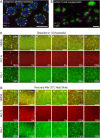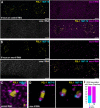Caenorhabditis elegans germ granules are present in distinct configurations and assemble in a hierarchical manner
- PMID: 38009921
- PMCID: PMC10753583
- DOI: 10.1242/dev.202284
Caenorhabditis elegans germ granules are present in distinct configurations and assemble in a hierarchical manner
Abstract
RNA silencing pathways are complex, highly conserved, and perform crucial regulatory roles. In Caenorhabditis elegans germlines, RNA surveillance occurs through a series of perinuclear germ granule compartments - P granules, Z granules, SIMR foci, and Mutator foci - multiple of which form via phase separation. Although the functions of individual germ granule proteins have been extensively studied, the relationships between germ granule compartments (collectively, 'nuage') are less understood. We find that key germ granule proteins assemble into separate but adjacent condensates, and that boundaries between germ granule compartments re-establish after perturbation. We discover a toroidal P granule morphology, which encircles the other germ granule compartments in a consistent exterior-to-interior spatial organization, providing broad implications for the trajectory of an RNA as it exits the nucleus. Moreover, we quantify the stoichiometric relationships between germ granule compartments and RNA to reveal discrete populations of nuage that assemble in a hierarchical manner and differentially associate with RNAi-targeted transcripts, possibly suggesting functional differences between nuage configurations. Our work creates a more accurate model of C. elegans nuage and informs the conceptualization of RNA silencing through the germ granule compartments.
Keywords: Caenorhabditis elegans; Gene regulation; Germ granules; Nuage; RNAi; Small RNAs.
© 2023. Published by The Company of Biologists Ltd.
Conflict of interest statement
Competing interests The authors declare no competing or financial interests.
Figures






Update of
-
Caenorhabditis elegans germ granules are present in distinct configurations that differentially associate with RNAi-targeted RNAs.bioRxiv [Preprint]. 2023 May 25:2023.05.25.542330. doi: 10.1101/2023.05.25.542330. bioRxiv. 2023. Update in: Development. 2023 Dec 15;150(24):dev202284. doi: 10.1242/dev.202284. PMID: 37292702 Free PMC article. Updated. Preprint.
References
-
- Andralojc, K. M., Campbell, A. C., Kelly, A. L., Terrey, M., Tanner, P. C., Gans, I. M., Senter-Zapata, M. J., Khokhar, E. S. and Updike, D. L. (2017). ELLI-1, a novel germline protein, modulates RNAi activity and P-granule accumulation in Caenorhabditis elegans. PLoS Genet. 13, e1006611. 10.1371/journal.pgen.1006611 - DOI - PMC - PubMed
-
- Ashe, A., Sapetschnig, A., Weick, E.-M., Mitchell, J., Bagijn, M. P., Cording, A. C., Doebley, A.-L., Goldstein, L. D., Lehrbach, N. J., Le Pen, J.et al. (2012). piRNAs can trigger a multigenerational epigenetic memory in the germline of C. elegans. Cell 150, 88-99. 10.1016/j.cell.2012.06.018 - DOI - PMC - PubMed
Publication types
MeSH terms
Substances
Grants and funding
LinkOut - more resources
Full Text Sources
Research Materials

